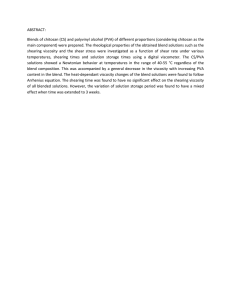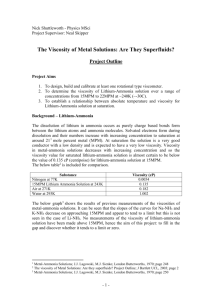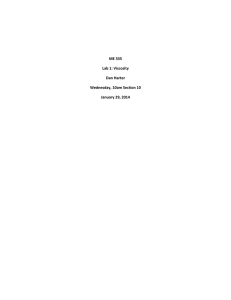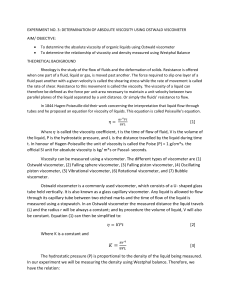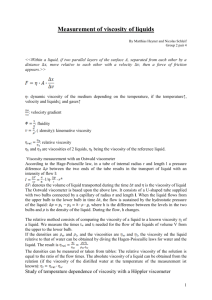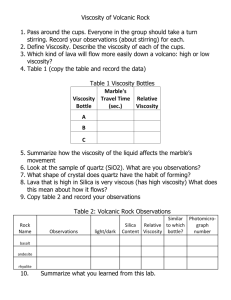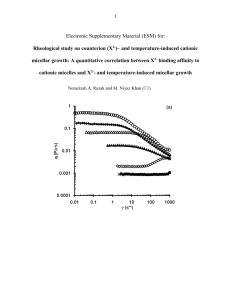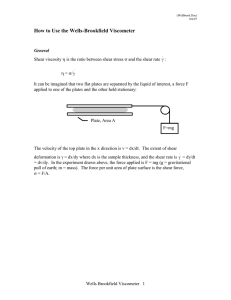Viscosity Lab Report Guidelines
advertisement
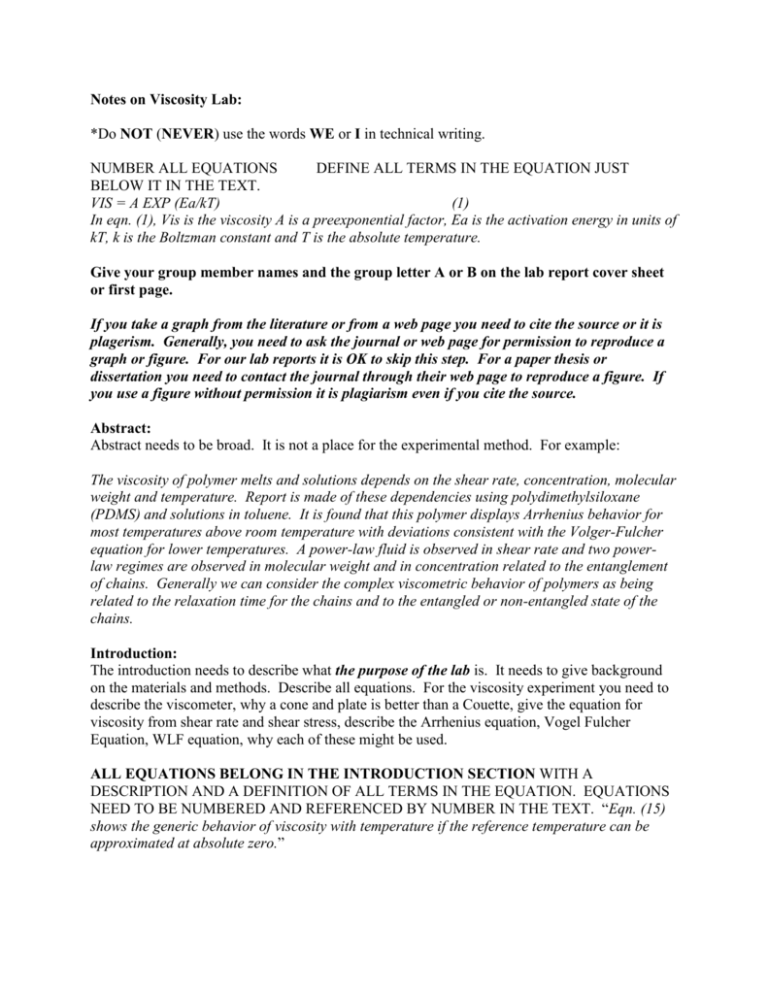
Notes on Viscosity Lab: *Do NOT (NEVER) use the words WE or I in technical writing. NUMBER ALL EQUATIONS DEFINE ALL TERMS IN THE EQUATION JUST BELOW IT IN THE TEXT. VIS = A EXP (Ea/kT) (1) In eqn. (1), Vis is the viscosity A is a preexponential factor, Ea is the activation energy in units of kT, k is the Boltzman constant and T is the absolute temperature. Give your group member names and the group letter A or B on the lab report cover sheet or first page. If you take a graph from the literature or from a web page you need to cite the source or it is plagerism. Generally, you need to ask the journal or web page for permission to reproduce a graph or figure. For our lab reports it is OK to skip this step. For a paper thesis or dissertation you need to contact the journal through their web page to reproduce a figure. If you use a figure without permission it is plagiarism even if you cite the source. Abstract: Abstract needs to be broad. It is not a place for the experimental method. For example: The viscosity of polymer melts and solutions depends on the shear rate, concentration, molecular weight and temperature. Report is made of these dependencies using polydimethylsiloxane (PDMS) and solutions in toluene. It is found that this polymer displays Arrhenius behavior for most temperatures above room temperature with deviations consistent with the Volger-Fulcher equation for lower temperatures. A power-law fluid is observed in shear rate and two powerlaw regimes are observed in molecular weight and in concentration related to the entanglement of chains. Generally we can consider the complex viscometric behavior of polymers as being related to the relaxation time for the chains and to the entangled or non-entangled state of the chains. Introduction: The introduction needs to describe what the purpose of the lab is. It needs to give background on the materials and methods. Describe all equations. For the viscosity experiment you need to describe the viscometer, why a cone and plate is better than a Couette, give the equation for viscosity from shear rate and shear stress, describe the Arrhenius equation, Vogel Fulcher Equation, WLF equation, why each of these might be used. ALL EQUATIONS BELONG IN THE INTRODUCTION SECTION WITH A DESCRIPTION AND A DEFINITION OF ALL TERMS IN THE EQUATION. EQUATIONS NEED TO BE NUMBERED AND REFERENCED BY NUMBER IN THE TEXT. “Eqn. (15) shows the generic behavior of viscosity with temperature if the reference temperature can be approximated at absolute zero.” Expermental: NO LISTS, NO NUMBERED STEPS. This is not a laundry list or a procedure from a lab instruction or lab book or viscometer manual. This is a text that you write in English so that someone can duplicate what you did and verify your experimental results. You need to give advice on how to run the measurements, what was done, anything you would need to reproduce the results for a person who knows what he is doing (NOT FOR AN IDIOT). A list of materials and steps is NOT appropriate. It needs to be readable. This should be a description in the tone of how you talk to someone in describing how to do this and then polish it up a bit. It doesn’t need to be poetry, but it needs to be readable. Just write this as if you were describing in English to your lab partner how you ran the experiment assuming he knows how to do it himself. You must skip details that are obvious but you need to point out ALL issues involving safety no matter how mundane. I.E. it is vital to wear goggles when using the Instron or impact machine. You need to stand back away from these machines etc. The viscometer is hot so use gloves to handle it or wait for it to cool. And the like… this is a liability issue. You must not give too much detail or give obvious instructions, e.g. “turn the machine on”, “press motor button on the panel of the viscometer to start the cone spindle running” These are wasting everyone’s time. Stick to things that are needed for a person of normal competence to do this measurement. You make yourself sound foolish if you give instructions like “walk into the lab, look for the viscometer” People know to wash the cup, but you need to tell them to wait for the instrument to reach steady state for 5 rotations to get good readings. Some of this is a judgment call but it should come natural to you eventually to not give too much detail but sufficient detail so that it seems that the experiment could be reproduced by someone knowledgeable in the field. Results/Calculations: NO BARE TABLES AND FIGURES. THESE NEED TO ALL HAVE TEXT INTRODUCING THEM BEFORE THEY ARE SHOWN THAT DESCRIBES THEIR RELEVANCE. HOW ARE THE EQUATIONS AND DESCRIPTION FROM THE INTRODUCTION USED TO MAKE PLOTS? e.g. Figure 1 shows an Arrhenius plot following equation (1). The linearity indicates that this is an Arrhenius fluid with an activation energy of … Joules. Plots need to have axes labeled with units. Figure caption needs to be below the figures and needs to reiterate what is plotted and what is being shown. The figure caption needs to be more or less readable to someone who is not going to read the text so that someone skimming through the document can sort out what you are getting at if they have a rudimentary understanding of the subject. The body of the text needs to describe what is being show in the plots even if it repeats what is in the figure caption. The figures are revered to in the text just before they appear in the document so that they are easy to find. You must mention the figure before you display the figure in the document (or at least on the same page). You need to use some logic in your discussion. If you see power-law behavior and no plateau in a plot of viscosity versus rate of strain then you have not observed the zero shear rate viscosity (see your quiz answers). This means that the results are compromised and some comparisons will not be valid, say between different molecular weight samples. Discussion of Error: This section is to give an understanding of where you gain your confidence in the results that you report. The section is to support your data not to detract from it. You are not looking for reasons to reject good data. “The samples were impure as they were several years old” This does not strengthen your argument. Unless you are trying to explain bad points this is useless information and serves to confuse the reader. Do you intend to tell the reader that you don’t believe any of what you did? This is counter productive. You need to sort out why you are considering error. This section has the purpose of justifying your confidence in your data and it should have a statement of the type: “THE RESULTS ARE ACCURATE TO WITHIN 1% WHICH IS SUFFICIENT TO JUSTFY THE CONCLUSIONS THAT … THE 1% ERROR IS ARRIVED AT BY CONSIDERING THE ERROR IN THE MEASUREMENT AND PROPAGATION OF THIS ERROR TO THE FIT RESULTS OR CALCUATED RESULTS ETC.” If you find problems with the data you need to explain what parts of the results are effected by these problems. How has it impacted your belief in the results. You are trying to justify your conclusions NOT undermine your arguments. You must support your results and conclusions in this section. Include a copy of your notebook section with the lab and a copy of the lab handout.


